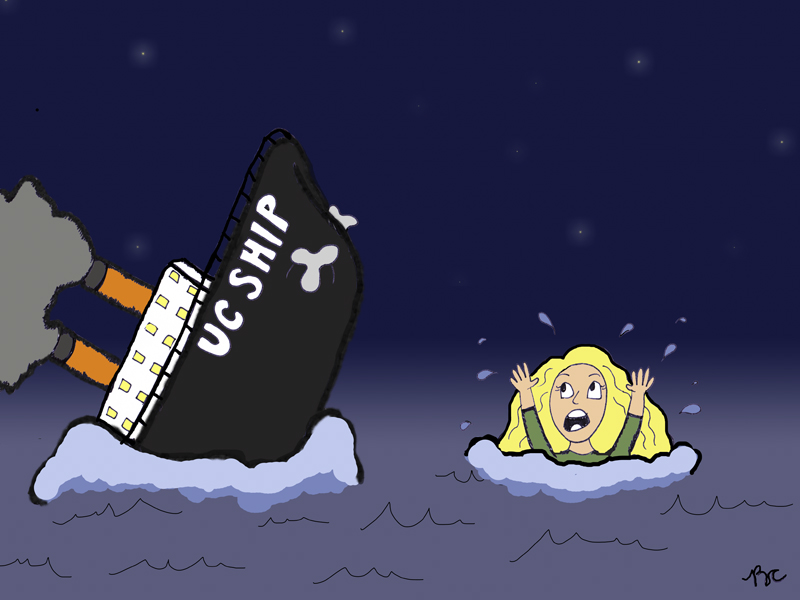
Thanks to the tireless efforts of the UC system, UCR students’ health care premiums are going up.
During the 2010-2011 academic year, UCOP took it upon itself to implement a UC-wide health insurance program that individual campuses could opt into called UC SHIP (Student Health Insurance Program). The reasoning behind this decision seemed straightforward enough: the UC system would keep student premiums down by taking on the financial risk providing medical coverage entails. That is, instead of the UC contracting with a health insurance company that would pay for medical procedures, the UC itself took on students’ medical costs. In so doing, and by providing access to a significantly larger student population, it was hoped that the UC would make costs more affordable to students while saving money.
A number of campuses were persuaded to join the fledgling UC SHIP during its first year of existence. UCR, however, declined—it was already contracting with a health insurance company that provided good care to students and kept costs relatively low.
But the shiny new SHIP program offered tantalizing benefits. Graduate student premiums would go down, while their dental and vision benefits would be expanded. Coverage of preventive care would increase. Students’ lifetime coverage caps would jump to $400,000, with a $10,000 pharmacy maximum. Each of these advantages individually were tempting enough. But together they were more than sufficient to convince UCR to accept a modest $10 increase in undergraduate student premiums and hop on the UC SHIP bandwagon the next year.
It probably seemed like a good idea at the time.
Before long, the allure of UC SHIP began to lose its luster. In UC SHIP’s very first year of operation on the campus, UCR alone racked up a $1,690,000 deficit. The next year, that number ballooned, resulting in UCR making up nearly $3.5 million of UC SHIP’s overall deficit.
But this was not merely a UCR problem—this was a UC problem. The company the UC system hired to generate premium rates and estimate the financial stability of the program, Aon Hewitt, botched its calculations. Instead of a hefty profit margin, as was originally estimated, the UC was hit with the news that UC SHIP was instead mired in a $57 million deficit. Now, the health insurance program once touted as helping the UC cope with uncertain state funding is adding $25 million in debt per year.
Guess who gets to foot the bill?
UC President Mark Yudof has stated that he doesn’t want students to pay the price for the error. But let’s be honest—in a cash-strapped university system where the state is not investing as much as it should be, where else will the burden fall? The UC is suing Aon Hewitt for its errors, but the court case is likely to drag on for years, and any money the UC wins will likely be swallowed up by the cost of suing the company in the first place. In the meantime, the UC SHIP deficit will keep festering. The funds to erase it have to come from somewhere, and the go-to places for funding have always been students’ pocketbooks.
Simply put: remaining onboard UC SHIP is not tenable. As the UC seeks to navigate a growing sea of red ink, UCR students would be slapped with the bill. We will already have to pay for the deep deficit UC SHIP is currently experiencing, and if we wait longer, the flailing health insurance program will accumulate even more debt, resulting in even greater hikes in student premiums.
Truth be told, the alternative isn’t smooth sailing. If UCR strikes out on its own, it will have to engage in a search for a health insurance company to contract with. Premiums in the short-term will probably increase. Graduate students will be hit hard, potentially resulting in a loss of Teaching Assistant positions.
But it’s the difference between standing on the Titanic as an iceberg cuts a gash through its hull and sitting in a lifeboat watching it go down. Neither is particularly enticing, but it is far better to be in the lifeboat than on the doomed ship.
UCR’s undergraduate student representatives on the Student Health Advisory Committee (SHAC) made the right decision when they voted on April 17 to opt for the lifeboats and discontinue UCR’s membership in the program. But it is up to Chancellor Jane Conoley to make the final decision about UCR’s status in UC SHIP after the Council of Chancellors meets on May 1. Students must make it clear that going down with UC SHIP and getting suckered into accepting the wretched state of our health insurance program is not the solution. We must stand up for our health because nobody else is going to.
Given the titanic impact on students, SHAC needs to do more to inform the campus about the impacts of the UC SHIP fiasco. ASUCR can prove its worth by campaigning against the harm UC SHIP poses and pressing the administration to ensure students avoid the brunt of the damage. The student body must take action to prevent its health insurance from being tied to the the deficit-ridden UC SHIP.
We shouldn’t be in this situation. UCR didn’t have to buckle to the pressure to join UC SHIP. But it did and here we are.
Now the UCR administration can redeem itself by being ready and able to make the tough decision that will secure the health of its students while minimizing the cost to students and UCR as a whole. After a stormy two years at sea, land is finally in sight. But UCR must chart its own course—free of UC SHIP—if it hopes to ever make landfall.








